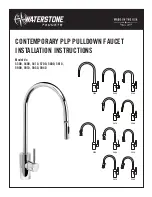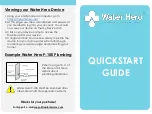
“Regumaq X-25” Troubleshooting
41
138112581-V01.10.2019
9.3.3
Decalcifi cation of the dismounted heat
exchanger
CAUTION
Risk of scalding due to hot fl uids!
If the station has been in operation, there is a
risk of scalding due to the unintentional dis-
charge of hot water or steam.
f
Allow the system to cool down.
f
Wear safety goggles.
CAUTION
Risk of burns due to hot components!
Any unprotected contact with hot components
may lead to burns.
f
Wear safety gloves.
NOTICE
Risk of damage due to pressure surge!
Sudden fi lling of the station with water may
lead to damage, for instance to the sensors or
sealing points.
f
Always open and close ball valves slowly.
1. Completely disconnect the controller (all poles) from
the power supply.
2. Close the isolating ball valve for potable hot water
(position 7 in Illust. 1 on page 10).
3. Close the isolating ball valve for potable cold water
(position 9 in Illust. 1 on page 10).
4. Close the isolating ball valve for the storage cylinder
circuit return (position 16 in Illust. 1 on page 10).
5. Close the isolating ball valve for the storage cylinder
circuit supply (see position 18 in Illust. 1 on page
10).
6. Unscrew the caps of the fi ll and drain ball valves
(positions 4, 6, 17 and 19 in Illust. 1 on page 10).
7. Connect a draining hose to each of the fi ll and drain
ball valves (positions 17 and 19 in Illust. 1 on page
10).
8. Open the fi ll and drain ball valves to empty the
pipes and the heat exchanger.
9. Loosen all four collar nuts from the heat exchanger
using SW 32 and 38 spanners.
10. Carefully remove the heat exchanger and lay it on
an even surface with the connections facing up.
Only use anti-liming agents that have been ap-
proved by the DVGW for decalcifi cation of the
heat exchanger, such as those with a citric acid
base. Please observe the DVGW worksheets
W 291 and 319!
Illust. 35:
Decalcifi cation of the dismounted heat
exchanger
11. Fill both of the heat exchanger circuits with anti-lim-
ing agent.
12. End the process once the prescribed exposure time
has elapsed.
The exposure times are dependent on the
anti-liming agent in use. Anti-liming agents
may need to be heated up. Please observe the
instructions provided by the manufacturer!
13. Drain the anti-liming agent.
14. Neutralise both of the heat exchanger circuits by
fl ushing with a lye.
15. Flush both of the heat exchanger circuits with pota-
ble water for at least a minute.
Once removed, the fl at seals cannot be reused.
Use new seals for reassembly (see „4.2 Sealing
set“ auf Seite 20).
16. Reinstall the heat exchanger in the station by fol-
lowing this sequence in reverse order.
17. Bleed the potable water circuit (see section 7.2 on
page 29) and the storage cylinder circuit (see
section 7.1 on page 28).
















































